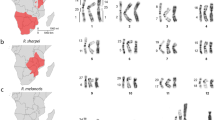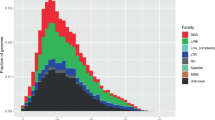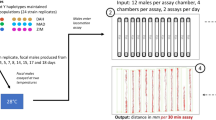Abstract
Inheritance and genetic linkage of 29 allozyme loci were studied by single-pair crosses of Yponomeuta padellus (Lepidoptera, Yponomeutidae). All loci segregated as Mendelian genes with codominant alleles except for a null allele at the hbdh locus. The three loci est-2, 6pgdh, and fudh were sex-linked and occurred in that order along the Z chromosome. Autosomal linkage analysis was facilitated by the lack of crossing-over in females characteristic of Lepidoptera, because linkage in female-informative crosses is all-or-none and observation of ‘forbidden recombinants’ provides conclusive evidence that two loci are not syntenic. Convincing evidence was found for linkage of the autosomal loci me and mpi. This linkage group and aat-1, ca, hbdh, hk-1, pgi and pgm were assigned to seven separate autosomes. Weaker evidence from male-informative families supported four additional linked pairs. Previous cytological studies have shown that the sex chromosomes in heterogametic females are associated in a trivalent, consisting of a W chromosome translocated to an autosome (Aw), paired with the Z chromosome and the homologous autosome A. Any locus located on this autosome and its homologous segment on the Aw chromosome should show strict segregation of one allele to sons and the other to daughters. However, none of the female-informative loci in this study satisfied that criterion. Use of the method of forbidden recombinants and its utility in the study of chromosomal evolution in Yponomeuta are discussed.
Similar content being viewed by others
Article PDF
References
Arduino, P, and Bullini, L. 1985. Reproductive isolation and genetic divergence between the small ermine moths Yponomeuta padellus and Yponomeuta malinellus. Atti Acad Naz Lincei Cl Sci Fis Mat Nat Rend, 18, 33–61.
Ayala, F J, Powell, J R, Tracey, M L, Mourāo, C A, and Pérez-Salas, S. 1972. Enzyme variability in the Drosophila willistoni group. IV. Genie variation in natural populations of Drosophila willistoni. Genetics, 70, 113–139.
Bennetzen, J L, and Freeling, M. 1993. Grasses as a single genetic system: genome composition, colinearity and compatibility. Trends Genet, 9, 259–261.
Berlocher, S H. 1993. Gametic disequilibrium between allozyme loci and sex chromosomes in the genus Rhagoletis. J Hered, 84, 431–437.
Clayton, J W, and Tretiak, D N. 1972. Amine-citrate buffers for pH control in starch gel electrophoresis. J Fish Res Board Canada, 29, 1169–1172.
Gershenzon, Z S. 1967. (On the question of species independence of the apple, fruit and willow ermine moths.) (In Russian). Vestn Zool, 3, 38–40.
Harris, H, and Hopkinson, D A. 1976. Handbook of Enzyme Electrophoresis in Human Genetics. North-Holland Publishing Company, Amsterdam.
Hebert, P D N, and Beaton, M J. 1989. Methodologies for Allozyme Analysis Using Cellulose Acetate Electrophoresis. Helena Laboratories, Beaumont, TX.
Heckel, D G. 1993. Comparative genetic linkage mapping in insects. Ann Rev Ent, 38, 381–408.
Hendrikse, A. 1988. Hybridization and sex-pheromone responses among members of the Yponomeuta padellus-complex. Entomologia exp appl, 48, 213–233.
Kuijten, P J. 1973. A gynandromorph of the small ermine moth, Yponomeuta cagnagellus (Hb.) (Lepidoptera, Yponomeutidae). Ent Ber Amst, 33, 221–222.
Menken, S B J. 1980a. Inheritance of allozymes in Yponomeuta (Lepidoptera). II. Interspecific crosses within the padellus-complex and reproductive isolation. Proc Kon Ned Akad Wet (C), 83, 425–431.
Menken, S B J. 1980b. Inheritance of allozymes in Yponomeuta (Lepidoptera). I. Intraspecific crosses in Y. cagnagellus. Proc Kon Ned Akad Wet (C), 83, 417–423.
Menken, S B J. 1982. Biochemical genetics and systematics of small ermine moths (Lepidoptera, Yponomeutidae). Z Zool Syst Evolut-forsch, 20, 131–143.
Menken, S B J. 1987. Is the extremely low heterozygosity level in Yponomeuta rorellus caused by bottlenecks? Evolution, 41, 630–637.
Menken, S B J, Herrebout, W M, and Wiebes, J T. 1992. Small ermine moths (Yponomeuta): their host relations and evolution. Ann Rev Ent, 37, 41–66.
Nilsson, N-O, Löfstedt, C, and Därving, L. 1988. Unusual sex chromosome inheritance in six species of small ermine moths (Yponomeuta, Yponomeutidae, Lepidoptera). Hereditas, 108, 259–265.
O'Brien, S J, Seuanez, H N, and Womack, J E. 1988. Mammalian genome organization: an evolutionary view. Ann Rev Genet, 22, 323–351.
Ott, J. 1991. Analysis of Human Genetic Linkage (revised edn). Johns Hopkins University Press, Baltimore.
Raumann, L E L. 1996. In search for Speciation: Genetical Differentiation and Host Race Formation in Yponomeuta padellus (Lepidoptera, Yponomeutidae) PhD thesis, University of Amsterdam.
Raijmann, L E L, and Menken, S B J. 1992. Population genetical evidence for host-race formation in Yponomeuta padellus. In: Menken, S. B. J., Visser, J. H. & Harrewijn, P (eds) Proceedings of the 8th International Symposium on Insect-Plant Relationships, pp. 209–212. Kluwer Academic Publishers, Dordrecht.
Robinson, R. 1971. Lepidoptera Genetics. Pergamon Press, Oxford.
Santos, O, and Luykx, P. 1985. Holozygosity for sex-linked genes in males of the termite Incisitermes schwarzi. Biochem Genet, 23, 729–740.
Schwartz, M K, Nisselbaum, J S, and Bodansky, O. 1963. Procedure for staining zones of activity of glutamic oxaloacetic transaminase following electrophoresis with starch gels. Am J Clin Pathol, 40, 103–106.
Selander, R K, Smith, M H, Yang, S Y, Johnson, W E, and Gentry, J B. 1971. Biochemical polymorphism and systematics in the genus Peromyscus. I. Variation in the old-field mouse (Peromyscus polionotus). In: Studies in Genetics, vol. 6, pp. 49–90. University of Texas Publication, 7013.
Sheppard, P M, Turner, J R G, Brown, K S, Benson, W W, and Singer, M C. 1985. Genetics and the evolution of Muellerian mimicry in Heliconius butterflies. Phil Trans R Soc B, 308, 433–610.
Shi, J, Heckel, D G, and Goldsmith, M R. 1995. A genetic linkage map for the domesticated silkworm, Bombyx mori, based on restriction fragment length polymorphisms. Genet Res, 66, 109–126.
Sperling, F. 1994. Sex-linked genes and species differences in Lepidoptera. Can Entomol, 126, 807–818.
Suiter, K A, Wendel, J F, and Case, J S. 1983. LINKAGE-l: a computer program for the detection and analysis of linkage. J Hered, 74, 203–204.
van Drongelen, W, and Van Loon, F F A. 1980. Inheritance of gustatory sensitivity in Fl progeny of crosses between Yponomeuta cagnagellus and Y. malinellus (Lepidoptera). Entomologia exp appl, 24, 199–203.
Author information
Authors and Affiliations
Corresponding author
Rights and permissions
About this article
Cite this article
Raijmann, L., van Ginkel, W., Heckel, D. et al. Inheritance and linkage of isozymes in Yponomeuta padellus (Lepidoptera, Yponomeutidae). Heredity 78, 645–654 (1997). https://doi.org/10.1038/hdy.1997.104
Received:
Issue date:
DOI: https://doi.org/10.1038/hdy.1997.104
Keywords
This article is cited by
-
Polyphyly and gene flow between non-sibling Heliconius species
BMC Biology (2006)



